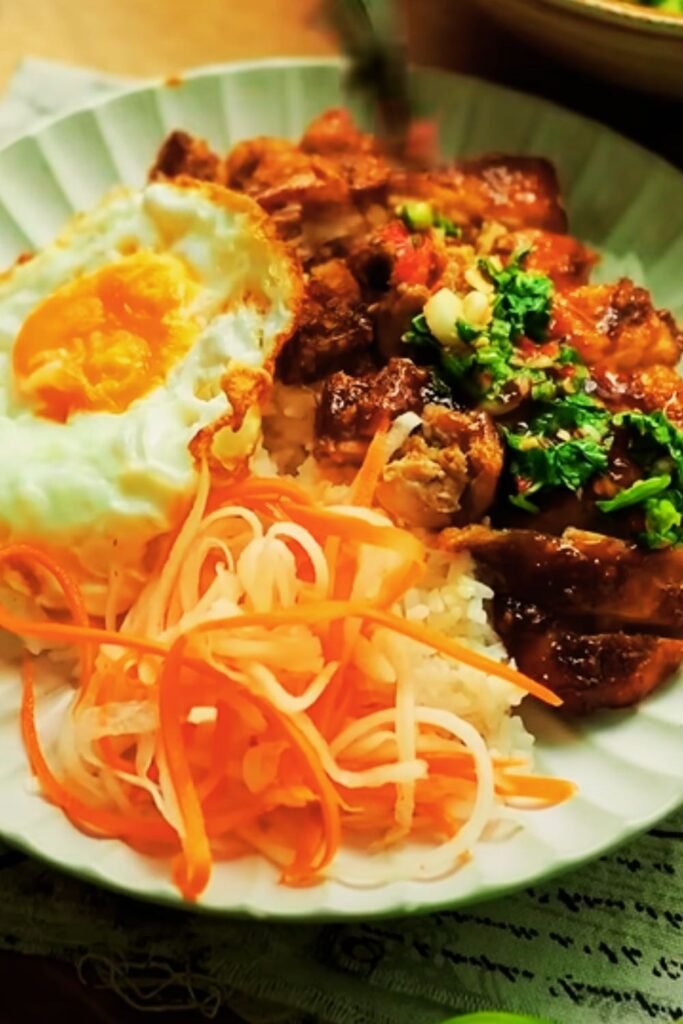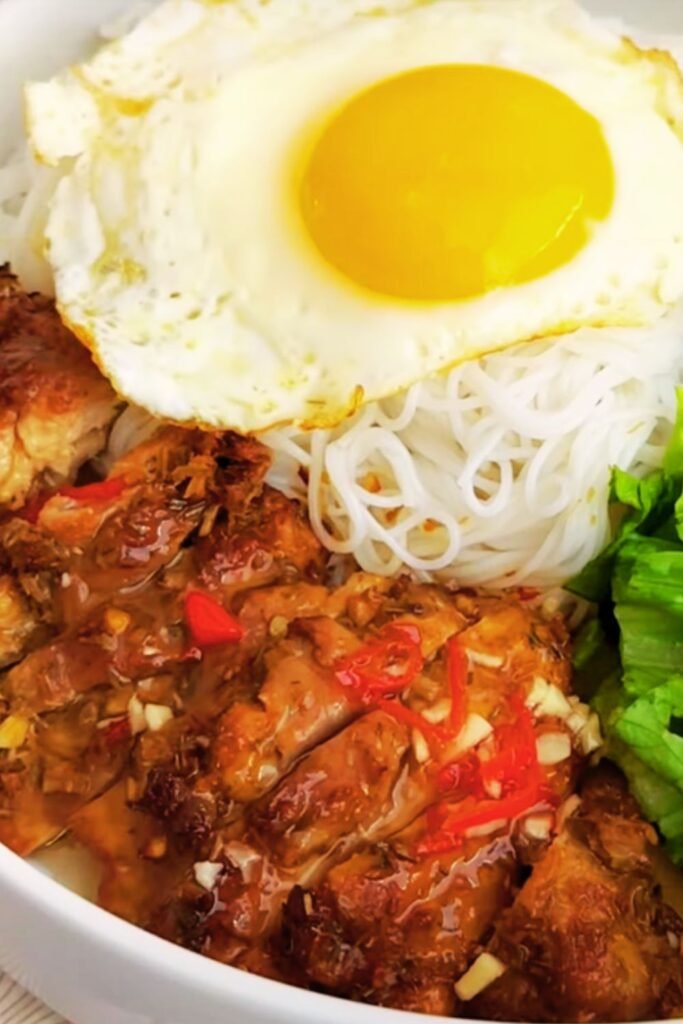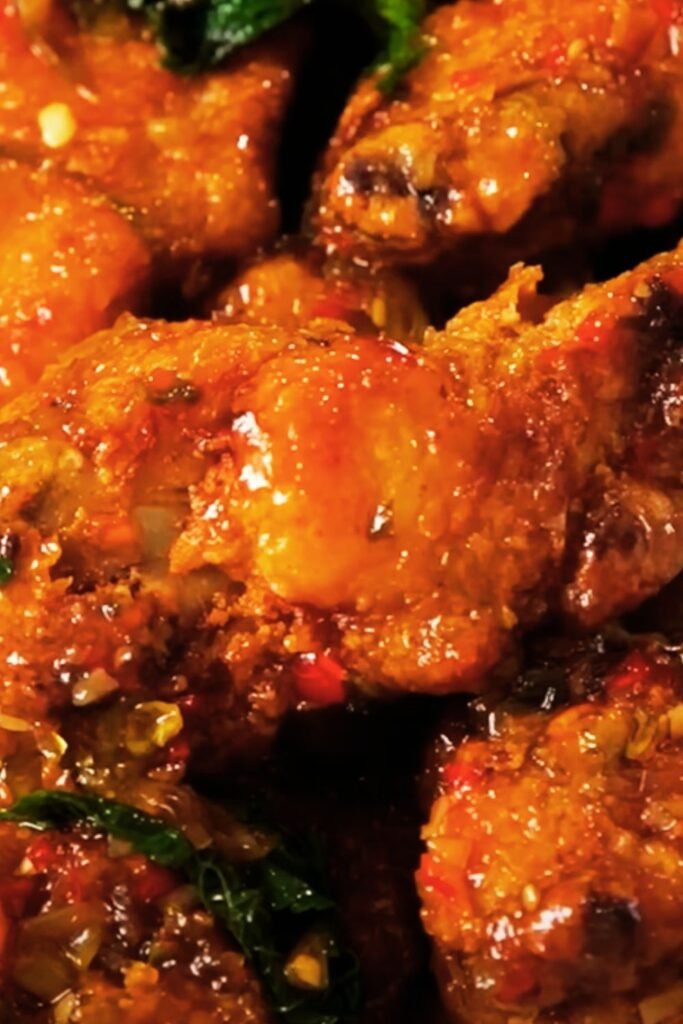When I first tasted authentic Vietnamese lemongrass chicken at a small family-run restaurant in Ho Chi Minh City, I knew I had to master this incredible dish. The aromatic blend of fresh lemongrass, tender chicken, and vibrant Vietnamese flavors created an unforgettable culinary experience that I’ve been perfecting in my own kitchen ever since.
Vietnamese lemongrass chicken, known as “Gà Nướng Sả” in Vietnamese, represents the heart of Vietnamese cuisine – fresh, aromatic, and beautifully balanced. This dish showcases how simple ingredients can transform into something extraordinary when combined with traditional techniques and genuine passion for cooking.
Understanding Vietnamese Lemongrass Chicken
Lemongrass (Sả): A tropical grass with a citrusy, lemony flavor and aroma, essential in Southeast Asian cooking. The tender inner stalks are used for cooking, while the outer layers are typically discarded.
Fish Sauce (Nước Mắm): A fundamental Vietnamese condiment made from fermented anchovies, providing umami depth and saltiness to dishes.
Palm Sugar: A natural sweetener derived from palm tree sap, offering a complex sweetness with caramel undertones that balances the dish’s flavors.
Galangal: A rhizome similar to ginger but with a more citrusy, pine-like flavor, commonly used in Vietnamese marinades.
Shallots: Small, mild onions that provide sweetness and depth when caramelized, preferred over regular onions in Vietnamese cuisine.
The Magic of Lemongrass in Vietnamese Cooking
Lemongrass holds a special place in Vietnamese culinary tradition. I’ve learned that the secret lies in properly preparing this aromatic herb. The fibrous outer layers must be removed to reveal the tender, flavorful core that infuses the chicken with its distinctive citrusy essence.
In Vietnamese households, lemongrass chicken is often prepared for special occasions and family gatherings. The preparation itself becomes a ritual – the careful pounding of lemongrass stalks, the patient marination process, and the precise grilling technique that creates those beautiful char marks while keeping the meat incredibly tender.
Essential Ingredients for Authentic Vietnamese Lemongrass Chicken
| Ingredient | Quantity | Purpose | Substitution |
|---|---|---|---|
| Chicken thighs (bone-in) | 2 lbs | Main protein, stays moist | Chicken drumsticks |
| Fresh lemongrass stalks | 4-5 stalks | Primary flavoring | Lemongrass paste (2 tbsp) |
| Fish sauce | 3 tablespoons | Umami base | Light soy sauce (less authentic) |
| Palm sugar | 2 tablespoons | Sweetness balance | Brown sugar |
| Garlic cloves | 6 cloves | Aromatic foundation | Garlic powder (1 tsp) |
| Shallots | 3 medium | Sweet onion flavor | Yellow onion (½ medium) |
| Galangal | 1 inch piece | Citrusy heat | Fresh ginger |
| Vegetable oil | 2 tablespoons | Marinade base | Neutral cooking oil |
| Lime juice | 2 tablespoons | Acidity balance | Lemon juice |
| Black pepper | 1 teaspoon | Spice element | White pepper |
Step-by-Step Preparation Guide
Preparing the Lemongrass
The foundation of exceptional Vietnamese lemongrass chicken begins with properly preparing the lemongrass stalks. I start by removing the tough outer layers until I reach the tender, pale yellow core. Using the flat side of my knife, I gently bruise the stalks to release their essential oils, then finely mince them.
Creating the Perfect Marinade
In my mortar and pestle – though a food processor works perfectly fine – I combine the minced lemongrass, garlic, shallots, and galangal. The rhythmic pounding creates a fragrant paste that forms the heart of our marinade. I then whisk in the fish sauce, palm sugar, lime juice, and black pepper until the sugar completely dissolves.

Marinating the Chicken
I score the chicken thighs in a crosshatch pattern, allowing the marinade to penetrate deeply into the meat. Each piece gets thoroughly coated with our aromatic mixture, then sealed in a container for at least 4 hours – though overnight marination yields the most incredible results.
Cooking Methods and Techniques
Traditional Grilling Method
Equipment needed:
- Charcoal grill or gas grill
- Grill grates
- Aluminum foil
- Meat thermometer
Grilling process:
- Preheat your grill to medium-high heat
- Oil the grates to prevent sticking
- Place marinated chicken skin-side down
- Grill for 6-8 minutes until beautiful char marks form
- Flip and continue grilling for 15-20 minutes
- Check internal temperature reaches 165°F (74°C)
Oven-Roasted Alternative
For those without access to a grill, I’ve perfected an oven method that delivers equally delicious results:
- Preheat oven to 425°F (220°C)
- Line a baking sheet with parchment paper
- Arrange marinated chicken pieces skin-side up
- Roast for 25-30 minutes until golden and cooked through
- Broil for final 2-3 minutes for extra crispiness
Pan-Seared Stovetop Method
Sometimes I crave this dish but want it quickly, so I use my trusty cast-iron skillet:
- Heat 2 tablespoons oil in a large skillet over medium-high heat
- Sear chicken skin-side down for 5-6 minutes
- Flip and cook for 12-15 minutes, covered
- Remove lid and cook final 3-4 minutes for crispy skin

Flavor Profile and Texture Analysis
| Cooking Method | Flavor Intensity | Texture | Preparation Time | Authenticity |
|---|---|---|---|---|
| Charcoal Grill | Excellent (10/10) | Smoky, tender | 45 minutes | Traditional |
| Gas Grill | Very Good (8/10) | Juicy, slightly crispy | 40 minutes | Near-traditional |
| Oven Roasted | Good (7/10) | Moist, evenly cooked | 35 minutes | Modern adaptation |
| Pan-Seared | Good (7/10) | Crispy skin, tender | 25 minutes | Quick alternative |
Serving Suggestions and Accompaniments
Vietnamese lemongrass chicken shines when paired with traditional accompaniments that complement its bold flavors. I always serve it with:
Traditional rice preparations:
- Jasmine rice steamed to perfection
- Coconut rice for added richness
- Vietnamese broken rice (Cơm Tấm) for authenticity
Fresh vegetable accompaniments:
- Crisp lettuce leaves for wrapping
- Cucumber slices for cooling contrast
- Fresh herbs including mint, cilantro, and Thai basil
- Pickled vegetables (đồ chua) for tangy balance
Sauce pairings:
- Nuoc cham dipping sauce
- Sriracha mayo for modern twist
- Sweet chili sauce for mild heat
Regional Variations Across Vietnam
Through my culinary travels across Vietnam, I’ve discovered fascinating regional variations of this beloved dish:
Northern Vietnam (Hanoi style):
- Uses more ginger and less sugar
- Often includes star anise in the marinade
- Traditionally grilled over charcoal braziers
Central Vietnam (Hue influence):
- Incorporates lemongrass leaves in the marinade
- Adds a touch of chili for heat
- Sometimes includes tamarind for tartness
Southern Vietnam (Saigon style):
- Sweeter profile with more palm sugar
- Often includes coconut milk in marinade
- Frequently served with fresh pineapple

Nutritional Benefits and Health Considerations
Vietnamese lemongrass chicken offers numerous health benefits that make it both delicious and nutritious:
Lemongrass benefits:
- Rich in antioxidants
- Natural anti-inflammatory properties
- Aids digestion
- Contains citral, which has antimicrobial effects
Chicken thigh advantages:
- Higher iron content than breast meat
- More flavorful due to fat content
- Stays moist during cooking
- Good source of protein and B vitamins
Overall nutritional profile per serving:
- Calories: 285
- Protein: 24g
- Carbohydrates: 8g
- Fat: 16g
- Sodium: 890mg
Storage and Meal Prep Tips
I often prepare large batches of this chicken for meal planning throughout the week:
Raw marinated chicken:
- Stores in refrigerator for up to 3 days
- Can be frozen for up to 3 months
- Thaw completely before cooking
Cooked chicken storage:
- Refrigerate for up to 4 days
- Reheat in oven at 350°F for best results
- Avoid microwaving to prevent drying out
Make-ahead strategies:
- Prepare marinade up to 1 week in advance
- Portion and freeze marinated chicken in individual servings
- Pre-chop vegetables and store separately
Troubleshooting Common Issues
Problem: Chicken turns out dry Solution: Use bone-in thighs instead of breasts, don’t overcook, and ensure adequate marination time.
Problem: Lemongrass flavor too mild Solution: Increase lemongrass quantity, ensure proper bruising of stalks, and extend marination time.
Problem: Marinade too salty Solution: Balance with additional palm sugar and lime juice, dilute with a small amount of water if necessary.
Problem: Chicken burns before cooking through Solution: Lower heat, move to cooler part of grill, or tent with foil during cooking.
Questions and Answers
Q: Can I use chicken breast instead of thighs for this recipe? A: While you can use chicken breast, I strongly recommend thighs for their superior flavor and moisture retention. If using breast meat, reduce cooking time and monitor temperature carefully to prevent drying out.
Q: Where can I find fresh lemongrass if my local grocery doesn’t carry it? A: Check Asian markets, health food stores, or online retailers. You can also substitute with lemongrass paste (use about 2 tablespoons) or frozen lemongrass, though fresh provides the best flavor.
Q: How spicy is this dish, and can I adjust the heat level? A: Traditional Vietnamese lemongrass chicken is mildly spiced with black pepper. To increase heat, add fresh chilies to the marinade or serve with spicy dipping sauce on the side.
Q: Is fish sauce absolutely necessary, or can I make this dish vegetarian-friendly? A: Fish sauce provides authentic umami flavor that’s difficult to replicate. For vegetarian versions, substitute with light soy sauce mixed with a pinch of seaweed powder, though the flavor profile will be different.
Q: Can I prepare this dish without a grill? A: Absolutely! I’ve provided oven and stovetop methods that work wonderfully. While you won’t get the traditional smoky flavor, the dish remains delicious and authentic in taste.
Q: How long should I marinate the chicken for optimal flavor? A: Minimum 4 hours, but overnight (8-12 hours) provides the best flavor penetration. I don’t recommend marinating longer than 24 hours as the acid can start to break down the meat texture.
Q: What’s the best way to tell when the chicken is perfectly cooked? A: Use a meat thermometer to ensure internal temperature reaches 165°F (74°C). The juices should run clear, and the meat should feel firm but not tough when pressed.
Q: Can I make this recipe ahead for entertaining? A: This dish is perfect for entertaining! Marinate the chicken the night before, then grill just before serving. The flavors actually improve with time, making it ideal for planned gatherings.
This Vietnamese lemongrass chicken recipe has become a cornerstone of my cooking repertoire, bringing the vibrant flavors of Southeast Asia to my dinner table. The combination of aromatic lemongrass, tender chicken, and traditional Vietnamese seasonings creates a dish that’s both exotic and comfortingly familiar. Whether you’re new to Vietnamese cuisine or a seasoned enthusiast, this recipe offers an accessible entry point into the rich culinary traditions of Vietnam while delivering restaurant-quality results in your own kitchen.